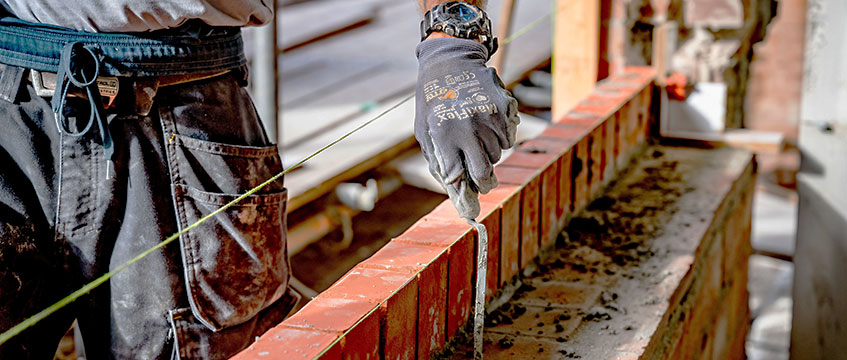Landlord and tenant — Service provisions — Window-cleaning services — Building of several storeys with a considerable number of large windows — Liability of lessees to contribute to the cost of window-cleaning — Lessees had accepted liability to contribute in the past — A change from a somewhat primitive system to more modern machinery had, however, involved an expensive installation and made higher contributions necessary
system of window-cleaning, operated by Office Cleaning Services, was based on a
movable apparatus consisting of a trolley made out of scaffolding, to which was
attached a cradle occupied by the cleaner and capable of being moved up and
down by him — When a vertical row was finished the cleaner hauled himself to
the top again, got out of the cradle and pushed the whole of the trolley along
until it was situated above the next row of windows to be cleaned — Although
this system, described by a witness as ‘ramshackle’, did work and was
considered to be reasonably safe, questions had been raised about its possible
replacement by something more up to date — The answer seemed to be to erect a
permanent fixture on the roof, of which the most efficient variety was a fully
automatic system, with automatic propulsion of the trolley along the roof and
automatic raising and lowering of the cradle — The plaintiff landlords decided
in favour of the fully automatic system, which was to cost in the end about
£70,000, more than twice the amount of the original quotation — It was found,
for example, that the roof had to be strengthened and rolled-steel joists laid
across it to carry the track for the trolley
for the judge was as to the legal right of the plaintiffs under the terms of
the underlease to require a contribution towards the costs of the new system —
Liability was governed by clause 2 and schedules 2 and 3, the second schedule
setting out the services for which payment had to be made and the third the
percentages payable — It was accepted that the only relevant provision was para
13 of the second schedule, which covered contributions to ‘The cost of
providing such other services as the lessor shall consider ought properly and
reasonably to be provided for the benefit of the building, or for the proper
maintenance and servicing of any part or parts thereof’ — The judge held that
the plaintiffs had ‘properly and reasonably’ considered that the improved
window-cleaning service was one which ought to be provided for the benefit of
the building and its proper maintenance and servicing — The question which had
now arisen was due only to the fairly heavy capital cost involved in the new
installation — The plaintiffs were accordingly held entitled to their money
claim against the defendants
No cases are
referred to in this report.
In this case
the plaintiffs, Sun Alliance & London Assurance Co Ltd, raised a point of
construction on the provisions of an underlease of two floors of a building,
Templegate House, Bristol, of which
they were the underlessors and the defendants, British Railways Board, the
underlessees. The point concerned the defendants’ liability to contribute to
the cost of window-cleaning.
Paul de la
Piquerie (instructed by Collyer-Bristow) appeared on behalf of the plaintiffs;
Jonathan Gaunt (instructed by M G Baker) represented the defendants.
Giving
judgment, WHITFORD J said: This case raises a short point of construction
against a background of facts which are not in dispute. In September 1972,
there was an underlease executed in which the defendants to this action, the
British Railways Board, took a lease of some floors of a building — the third
and fourth floors, I think — from a company, to whose interest the present
plaintiffs have succeeded.
I can deal
briefly with the background facts, which are not in dispute: over a long period
this building, which is to be seen in three photographs which have been handed
up to me and I think have been provided by the defendants, was serviced so far
as the cleaning of windows was concerned by a company, Office Cleaning
Services. It is a sizeable property — Templegate House in Bristol — and the
third of these photographs which shows the facade indicates that there are a
considerable number of large windows which have to be cleaned, as is becoming
increasingly the case with modern developments. Since the 1970s when this
building was put up, we have come to a point where the exterior of a building
is very often nothing but one vast window, which has meant that so far as
window-cleaning is concerned, as I understand it, in the original construction
of the building provision is made which would not have been made at the time
when Templegate House went up.
What was done
was that Office Cleaning Services were hired to carry out the window-cleaning.
They did this by means of an apparatus which they provided — a trolley made out
of scaffolding — and in the agreed bundle there are two photographs which
illustrate quite clearly what the nature of this equipment was. As I have said,
it is a trolley made out of scaffolding with wheels in front and wheels at the
back. If one looks at the top photograph, there are two arms projecting out
from the base at an angle of what appears to me to be slightly less than 45
degrees. The ends hang over the face of the building. At the rear end of this
trolley there is a crossbar which has got some hooked members on it, and on
those hooked members are suspended weights. The weights can be seen quite
clearly in the bottom photograph, though they are standing on the roof and are
not hooked on the hooks. When this is set up, there is then attached to the
front of the trolley a cradle which can be raised and lowered by an occupant of
the cradle. It is raised and lowered, of course, manually. This means a good
deal of trailing rope up and down the front of the building.
When one row
of windows, looking at the facade of Templegate House vertically, has been
cleaned, the man doing the cleaning hauls himself up to the top, gets out of
the cradle, probably I should have thought takes off the weights, and then
pushes the whole of the trolley along till it is situated above the next row of
windows to be cleaned. This is a type of apparatus that was described by one of
the witnesses called before me as ramshackle, and I find myself inclined to
agree with him in the description which he gave. This was a Mr Nicholson, an
employee of a firm who acted as managers for, I think, a number of the
plaintiffs’ properties including Templegate House.
In 1978 one of
the tenants, Property Services Agency, caused a letter to be sent to the
plaintiffs drawing their attention to the Health
window-cleaning. There was some reference made to various provisions of the Act
and a query was raised as to whether the system at that time in operation —
which as I understand it was the system I have roughly described — was
considered satisfactory and, if not, what was going to be done about it.
Well, this led
to a series of enquiries which went on over a considerable period of time.
Office Cleaning Services were, understandably enough, consulted. They
apparently have a safety officer, who expressed the view that this fairly
primitive trolley was safe enough. None the less, it was decided that maybe in
course of time it might be desirable to think of using some slightly different,
perhaps less primitive, system. So much emerged from the evidence given by a Mr
Chapman, who was charged with carrying out some investigation into what might
be done. When he approached this task, Mr Chapman did it on the basis that it
was his understanding that, although Office Cleaning Services had formed the
view that the system operating with the push trolley was satisfactory, they had
in fact also expressed the opinion that it might in course of time be desirable
to adopt a more permanent system.
There is in
the agreed bundle a note from Mr Chapman to Mr Nicholson in which he deals with
the results of some of his investigations, including some information which he
received from the factory inspectorate with regard to the possible use of
safety bolts so that each window could be individually cleaned by a man letting
himself out through the window, equipped with a harness attached to the safety
bolts; a proposal for an alternative which, I think sensibly enough, was not
adopted, having regard to the inconvenience to the tenants if nothing else. But
at any rate, he dealt with that, and although from the written documents one
might have gathered that Office Cleaning Services thought everything was
perfectly satisfactory, from questions put to Mr Chapman in cross-examination
it clearly emerged that he had been told, both as I understand it through the
suggestions of Office Cleaning Services and through his dealings with the
factory inspectorate, that although the existing provision might be satisfactory
enough if it were considered as one that was going to be worked on a temporary
basis, in the long term something better ought to be done.
Quite plainly,
the plaintiffs were troubled about all this, and Mr Gaunt, who has appeared for
the defendants, does not suggest there was any reason why they should not be
worried. They thought about alternative possibilities; I have mentioned safety
bolts, with each window as it were being dealt with individually by a man
climbing out. There was some question as to whether the windows — which I
gather are sash windows — could be made to swivel so that the outside could be
cleaned from the inside; but that would have cost a sum far in excess of that
which in the end was paid for the installation of a system operating from the
roof; and again, like the safety bolts, it would have been of extreme
inconvenience to the tenants on the occasion of window-cleaning taking place.
So having
investigated the alternatives, in the end a decision was taken to install some
permanent system on the roof, which might have taken one of three different
forms. One was described as a fully manual system, but operating upon the basis
of a permanent track along which a trolley could be moved by hand with the
cradle being raised and lowered by hand — as of course was the case with the
system already in operation, albeit, as I have said, with this somewhat
ramshackle device. This would have involved less expenditure, obviously enough,
than the semi-automatic system, which was also considered, with a mechanism to
wind the cradle up and down, the trolley still being pushed by hand. The third
alternative was a fully automatic system, automatic propulsion of the trolley
along the roof and automatic raising and lowering of the cradle. In the end, it
was thought — and I think perfectly reasonably thought, and indeed Mr Gaunt did
not suggest that this was not reasonable — that a fully automatic system would
be best.
It was going
to cost rather more than the semi-automatic or manual system would, and the
original figure which I think was something in the region of £30,000 for the
complete installation eventually amounted to rather more than twice that sum —
no doubt in part because over the period from the original quotation to the
period of the execution of the work inflation would have played its part —
mainly because structural engineers ascertained that the roof of Templegate
House was not sufficiently sound to carry the installation proposed without
strengthening, and in the result rolled-steel joists had to be laid across the
roof to carry the track for the trolley, all of which added quite considerably
to the cost, but the more especially because, as I understand, certain pipework
on the roof had to be repositioned so as to make it possible to put in the rolled-steel
joists.
It was all
done, and the system went into operation, and the only question that I have to
decide is whether, under the terms of the lease, the plaintiffs are right when
they say, as they do, that the defendants must meet some part of the cost
involved.
The underlease
in question is to be found in the agreed bundle. The questions which I have to
consider really fall to be considered in the main under the schedules, but they
arise in this way: there is in clause 2, which is concerned with the question
of sums to be paid by the lessee, a provision that ‘they’ — in this case of
course British Rail — ‘shall pay to the landlord for the services provided or
undertaken by the landlord as set out in the second schedule hereto, an amount
calculated and payable in accordance with the provisions of the third schedule
hereto’.
So we get to
the second and the third schedules. The third schedule is merely concerned with
the percentage to be payable of any of the services which are dealt with in the
second schedule.
The second
schedule starts with a definition of common areas. Para 2 — and of course we
are now on the services in respect of which contribution has to be made — is
concerned with repairing, decorating, maintaining, renewing, rebuilding,
lighting, heating, cleansing, providing for the security, control and
management of the common areas, hot water to common toilets, and so forth. Para
3 is concerned with the cost and expense of maintaining in good order and
condition the exterior walls, roof, foundations and main structure of the
building, and main drains and exterior pipes serving the same. Para 4, with the
cost and expense of repairing, maintaining and rebuilding any part of the
building in accordance with clause 4(3). Para 5, with the cost or amount of all
charges, assessments and outgoings for rates, water, electricity and gas
charges, telephone and public or other statutory utilities payable in respect
of any accommodation provided by the lessor for staff. So far, we are not
really dealing with anything which was suggested on either side as having any
relevance to the matter I have to consider, save for one point raised by Mr
Gaunt to which I shall be returning.
In opening, I
had understood that some reliance was going to be placed by the plaintiffs on
para 6, but in the end the point was abandoned. Para 6 requires a contribution
in respect of the cost of maintaining in good working order, and operating, all
electrical, mechanical and other plant, equipment, chattels and fittings of
ornament or utility in use for common benefit, including lifts, heating,
cooling and ventilation equipment, cleaning equipment, fire fighting, and fire
prevention equipment, fire and burglar alarm systems, where the use and benefit
of such specialist services are made available for the use or benefit of the
demised premises, and including the cost of provision for renewal and
replacement whenever necessary.
Now, as I have
said, the plaintiffs do not rely upon para 6. Mr Gaunt did make some point on
clause 6 because he pointed out that para 6 is concerned with the cost of
maintaining in good working order and operating, among other things, cleaning
equipment. Well of course, at the time this was entered into, there was not any
plant in connection with the cleaning of windows, that belonged to the lessors.
In so far as there was any plant, the trolley made out of scaffold poles, it
was plant which belonged to Office Cleaning Services, and para 6 would have had
no effect so far as it was concerned, because the cost of maintaining and
keeping it in good working order was the responsibility of Office Cleaning
Services and nobody else; as indeed, at that time, would have been the cost of
renewal and replacement. I may say that at one stage the trolley that was used
by OCS was replaced because it was, as I understand it, wearing out.
Para 7 is
concerned with the cost of providing accommodation for staff, personnel and
plant. Para 8 deals with refuse collection; para 9, the cost of providing
maintenance staff and maintaining the parts of the building for which the
lessor accepts responsibility; para 10, the cost of periodic payments in
respect of National Health and Insurance and so forth; para 11, the fees of the
lessor’s managing agents in respect of the administration of the building, the
supervision of the services, and cost to the lessor of the preparation of any
statements or certificates, as specified in the next schedule; and para 12, the
cost to the lessor of the supply of heat to the building over a certain period
and on certain days. So we come to para 13, which is,
of any materiality, because under this there is an obligation to make
contribution in respect of:
The cost of providing such other services
as the lessor shall consider ought properly and reasonably to be provided for
the benefit of the building, or for the proper maintenance and servicing of any
part or parts thereof.
Now, to my
mind, there being no express provision in regard to window-cleaning so far as
the second schedule is concerned, that is properly to be considered as being
another service, which the lessor undoubtedly ought to provide for the benefit
of the building, and the proper maintenance and servicing of any part or parts.
I should just
mention this about the window-cleaning, that it was pointed out to me by Mr
Gaunt that there is in fact a reference to window-cleaning to be found in the
lease. It is where clause 5 provides that ‘during the continuance of the term,
the lessee shall keep the glass in the windows of the premises demised to them
clean’. And it was suggested that this might relate both to the inside and to
the outside. Having regard to the fact that, as I have said, these were sash
windows, without bolts it would be against the relevant provisions of the 1974
Act to allow people to go outside to clean. In any event, with sash windows, it
could never be satisfactorily done without the greatest difficulty; and I do
not myself think that this particular provision in the lease itself is of any
relevance to the point which I have to consider, which is really dealing with
providing a service which ought properly and reasonably to be provided for the
benefit of the building, or for the proper maintenance of any part of it; that
is to say, so far as window-cleaning is concerned, keeping the outside of the
building in proper shape.
Now, it
undoubtedly appears to be the case, as I understand it, that the cost of
window-cleaning by OCS using their somewhat primitive trolley was always
accepted as being a service in respect of which a contribution was payable by
the defendants, and they have in fact always made a contribution. So the only
question is what were the plaintiffs’ intentions when they came to the
conclusion that the existing services by way of OCS’s somewhat primitive
trolley ought to be improved by the provision of the new system which has been
installed at a cost of something of the order of £70,000. When the plaintiffs
decided to accept a tender and to allow the work to proceed, were they
embarking upon the cost of providing a service such as they, as lessors,
considered ought properly and reasonably to be provided for the benefit of the
building?
The matter was
quite plainly considered with the greatest care by the managing agents (as I
say, I have heard Mr Nicholson and Mr Chapman) and with the greatest care by
those who had the consideration of this matter in the plaintiff organisation,
and I have heard in particular Mr Day who from 1981 onwards was the plaintiffs’
regional management surveyor for the western region in which Bristol and
accordingly this building lies. It was making provision for a service, another
service, and if para 6, to which I was specifically referred by Mr Gaunt, has
any application at all, it is only because to my mind the provision of a
window-cleaning service can sensibly be said to be of the kind contemplated at
least in para 6. So it was a consideration of providing such a service, it is
right to say, in substitution for the existing service. But I am unable to
accept the submission made by Mr Gaunt on behalf of the defendants that it is
not a matter that falls within the purview of para 13 at all. It appears to me
that there was an obligation at all times resting upon the plaintiffs to make
provision for a window-cleaning service. So the difficulty that has arisen has
arisen really because of the fairly heavy capital cost that has been involved
in substituting for the OCS trolley a proper, modern, up-to-date system of
operation.
It was not, so
far as the evidence goes, essential to do this for safety reasons — a point
much relied upon by Mr Gaunt. It has not, so far as the evidence goes, at least
up to the present, produced any very great benefit to the tenants in terms of
economy and cost, though in the long term I suppose it may. Further — and this
was the third point made by Mr Gaunt — if one considers the capital cost
involved as against the annual expenditure of what I think Mr Gaunt was
prepared to concede might be something approaching £1,000 a year in respect of
the cost of window-cleaning with the old OCS system, it is out of all
proportion to that.
But I am
concerned only with a consideration of the words by which the parties have
chosen to bind themselves. These are words which were accepted by the
defendants, and in my opinion the plaintiffs are right when they suggest, as
they do, that the cost of providing this updated service is one which falls
within the terms of para 13 of the second schedule, and the plaintiffs are
entitled to their money claim accordingly.








